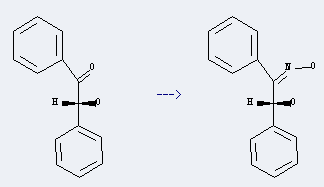-
Name
ALPHA-BENZOIN OXIME
- EINECS 207-127-2
- CAS No. 441-38-3
- Article Data13
- CAS DataBase
- Density 1.13 g/cm3
- Solubility ethanol: 0.1 g/mL, clear
- Melting Point 153-155 °C(lit.)
- Formula C14H13NO2
- Boiling Point 417.8 °C at 760 mmHg
- Molecular Weight 227.263
- Flash Point 270.4 °C
- Transport Information
- Appearance white crystalline powder
- Safety 22-24/25
- Risk Codes
-
Molecular Structure
- Hazard Symbols
- Synonyms Benzoin,oxime (6CI,7CI,8CI);2-Hydroxy-1,2-diphenylethanoneoxime;NSC 659;dl-Benzoin anti-oxime;
- PSA 52.82000
- LogP 2.59850
alpha-Benzoin oxime Consensus Reports
Reported in EPA TSCA Inventory.
alpha-Benzoin oxime Specification
The alpha-Benzoin oxime is an organic compound with the formula C14H13NO2. The IUPAC name of this chemical is (2E)-2-hydroxyimino-1,2-diphenylethanol. With the CAS registry number 441-38-3, it is also named as (E)-2-Hydroxy-1,2-diphenylethanone oxime. The product's categories are Aromatic Hydrazides; Hydrazines; Hydrazones and Oximes. Besides, it should be stored in a closed and dark place. It has been used for inspection and determination of copper, molybdenum and tungsten, and is also used as chelating agent in extraction of tantalum, vanadium, tungsten.
Physical properties about alpha-Benzoin oxime are: (1)ACD/LogP: 2.82; (2)ACD/LogD (pH 5.5): 2.82; (3)ACD/LogD (pH 7.4): 2.82; (4)ACD/BCF (pH 5.5): 82.08; (5)ACD/BCF (pH 7.4): 82.04; (6)ACD/KOC (pH 5.5): 816.27; (7)ACD/KOC (pH 7.4): 815.87; (8)#H bond acceptors: 3; (9)#H bond donors: 2; (10)#Freely Rotating Bonds: 5; (11)Polar Surface Area: 30.82 Å2; (12)Index of Refraction: 1.58; (13)Molar Refractivity: 66.72 cm3; (14)Molar Volume: 200.2 cm3; (15)Polarizability: 26.45×10-24cm3; (16)Surface Tension: 44.2 dyne/cm; (17)Density: 1.13 g/cm3; (18)Flash Point: 270.4 °C; (19)Enthalpy of Vaporization: 70.77 kJ/mol; (20)Boiling Point: 417.8 °C at 760 mmHg; (21)Vapour Pressure: 9.98E-08 mmHg at 25°C.
Preparation: this chemical can be prepared by (R)-Benzoin. This reaction will need reagent NH2OH*HCl and solvent ethanol, H2O. The yield is about 100%.

You can still convert the following datas into molecular structure:
(1)SMILES: OC(C(=N\O)\c1ccccc1)c2ccccc2
(2)InChI: InChI=1/C14H13NO2/c16-14(12-9-5-2-6-10-12)13(15-17)11-7-3-1-4-8-11/h1-10,14,16-17H/b15-13+
(3)InChIKey: WAKHLWOJMHVUJC-FYWRMAATB
(4)Std. InChI: InChI=1S/C14H13NO2/c16-14(12-9-5-2-6-10-12)13(15-17)11-7-3-1-4-8-11/h1-10,14,16-17H/b15-13+
(5)Std. InChIKey: WAKHLWOJMHVUJC-FYWRMAATSA-N
The toxicity data is as follows:
| Organism | Test Type | Route | Reported Dose (Normalized Dose) | Effect | Source |
|---|---|---|---|---|---|
| mouse | LD50 | intraperitoneal | 150mg/kg (150mg/kg) | National Technical Information Service. Vol. AD691-490, | |
| rat | LD | oral | > 500mg/kg (500mg/kg) | National Academy of Sciences, National Research Council, Chemical-Biological Coordination Center, Review. Vol. 5, Pg. 9, 1953. |
Related Products
- alpha-Benzoin oxime
- 4414-81-7
- 4414-88-4
- 4414-89-5
- 4415-73-0
- 4415-82-1
- 4415-83-2
- 4415-87-6
- 441715-01-1
- 441717-40-4
- 441774-09-0
Hot Products
About|Contact|Cas|Product Name|Molecular|Country|Encyclopedia
Message|New Cas|MSDS|Service|Advertisement|CAS DataBase|Article Data|Manufacturers | Chemical Catalog
©2008 LookChem.com,License: ICP
NO.:Zhejiang16009103
complaints:service@lookchem.com Desktop View